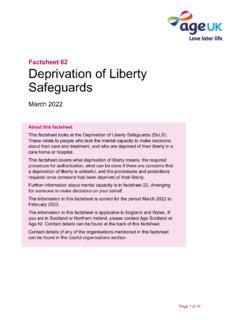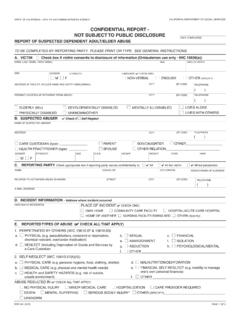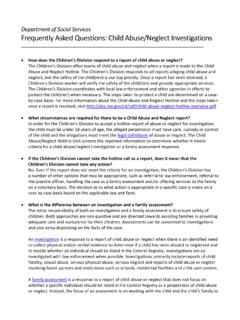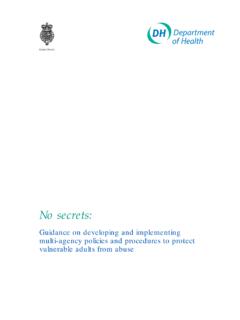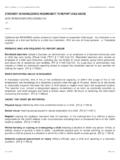Transcription of Safeguarding order people from abuse and neglect
1 Page 1 of 28 Factsheet 78 Safeguarding older people from abuse and neglect December 2021 About this factsheet This factsheet explains the law on Safeguarding adults to help you decide what to do if you think an older person is being abused or neglected, or may be at risk of abuse or neglect . Whether you know the person through your role as a professional, a carer, relative, neighbour or friend, you have an important part to play in helping to safeguard them. Safeguarding means protecting people s right to live in safety, free from abuse and neglect . Any form of abuse or neglect is unacceptable and never justifiable, no matter what reason may be given for it. It is very important that older people are aware of this and they know support is available.
2 This factsheet describes the situation in England. There are differences in legislation and procedures in Northern Ireland, Scotland and Wales. Readers in these nations should contact Age NI, Age Scotland, or Age Cymru for information specific to where you live. Contact details of any organisation mentioned in this factsheet can be found in the Useful organisations section. Age UK factsheet 78 December 2021 Safeguarding older people from abuse and neglect Page 2 of 28 Contents 1 Background and legal framework 4 The aims of adult Safeguarding 4 Safeguarding is everybody s business 5 Making Safeguarding personal 5 2 Types of abuse or neglect 6 Particular issues for older people 8 Who does the Safeguarding law seek to protect? 8 3 What should I do if I suspect abuse or neglect ?
3 9 4 How to raise concerns about abuse or neglect 10 The local authority duty to make enquiries 11 Who should carry out the enquiry? 12 The involvement of the person in an enquiry 12 If the person lacks mental capacity 13 What is the likely outcome of an enquiry? 14 5 Local authority Safeguarding duties 14 Role and duties of Safeguarding Adults Board 15 Safeguarding Adults Reviews 15 6 What happens if a crime has been committed? 16 Issues affecting criminal investigations 16 7 What other legal powers exist? 18 Police powers entry, arrest and custody 18 Domestic abuse and controlling/coercive behaviour 18 Can a person be removed from their own home? 19 Mental Health Act 1983 20 Mental Capacity Act 2005 20 Deprivation of Liberty Safeguards (DoLS) 21 The inherent jurisdiction of the High Court 21 8 Court of Protection and the Office of the Public Guardian 22 Age UK factsheet 78 December 2021 Safeguarding older people from abuse and neglect Page 3 of 28 9 The Care Quality Commission s standards 23 Notification duties 24 10 The Disclosure and Barring Service 24 Useful organisations 25 Age UK 27 Support our work 27 Age UK factsheet 78 December 2021 Safeguarding older people from abuse and neglect Page 4 of 28 1 Background and legal framework The information in this factsheet is based on sections 42-46 and Schedule 2 of the Care Act 2014 ( the Act )
4 And chapter 14 of the Care and Support Statutory Guidance ( the guidance ). Section 1 of the Act requires a local authority to promote individual wellbeing in all it does, including protection from abuse and neglect . The Act holds that local authorities are the lead adult Safeguarding agencies and are generally the first point of contact for raising concerns. Human rights and Safeguarding The Safeguarding elements in the Act complement broader human rights protections. The Human Rights Act 1998 includes a right not to be subject to torture, inhuman or degrading treatment (article 3) and a right to enjoy private, family and home life without unjustified interference from public authorities (article 8). abuse can be a violation of article 3, whilst risk averse or disproportionate public authority responses can be a violation of article 8.
5 If abuse takes place in a family or at home, a local authority must think about the rights of the individual and their family to home and family life. Sometimes this means balancing conflicting rights. The aims of adult Safeguarding The guidance states the aims of adult Safeguarding are to: stop abuse and neglect where possible prevent harm and reduce the risk of abuse and neglect safeguard people in a way that supports them in making choices and having control about how they want to live concentrate on improving life for the person concerned raise public awareness so communities play a role alongside professionals provide accessible information, advice, and support about how to stay safe and how to raise a concern address the cause of the abuse and neglect .
6 Who is adult Safeguarding for? Safeguarding duties seek to protect all adults who: have needs for care and support (whether or not the local authority meets any of those needs), and are experiencing, or at risk of, abuse or neglect , and as a result of those care and support needs are unable to protect themselves from the risk of, or the experience of, abuse or neglect . Age UK factsheet 78 December 2021 Safeguarding older people from abuse and neglect Page 5 of 28 Safeguarding is everybody s business This refers to the importance of everyone being alert to possible signs of abuse or neglect and acting on their concerns. It includes friends and family, health and social care professionals and other public sector staff, for example in the housing sector or social security.
7 It applies to the police, as abusive or neglectful behaviour can also be a criminal offence (see section 6). It is relevant to some private sector agencies and not limited to those providing social and health care. For example, staff in financial institutions such as banks should be aware of the prevalence of financial abuse of older people and be alert to signs it may be taking place. Cooperation Cooperation duties between relevant agencies and the requirement to have a multi-agency approach to Safeguarding is included in the Act. Every local authority must have a Safeguarding Adults Board which brings together a range of local organisations to review and improve Safeguarding activity. Some areas may also have a multi-agency Safeguarding hub or MASH.
8 Early sharing of information can be the key to an effective Safeguarding response and all concerned must sign up to agreed procedures (see section 5). Making Safeguarding personal This emphasises the importance of adults at risk being as involved as possible in a Safeguarding process. With some exceptions, Safeguarding enquiries should only take place with the consent and engagement of the person concerned. Where suspicions of abuse or neglect arise, the extent of an enquiry depends on the circumstances of the individual case and the views of the person at the heart of it. As with other aspects of social care, the wellbeing of the person is of central importance throughout the Safeguarding process. This includes control over their day-to-day life and recognising the person is best-placed to understand their own wellbeing requirements.
9 In Safeguarding cases, there can be a difficult balance for professionals to strike between protecting people from harm and empowering people to make their own choices and remain in control of their lives. This can mean respecting an older person s choice, even though this puts them at risk of harm. Social care professionals must work within the legal and policy framework and their powers to intervene may at times be limited if the person has mental capacity to make informed decisions. Age UK factsheet 78 December 2021 Safeguarding older people from abuse and neglect Page 6 of 28 2 Types of abuse or neglect There is no overarching definition of abuse or neglect . The guidance notes local authorities should not limit their view of what constitutes abuse or neglect , as they can take many forms and the circumstances of the individual case should always be considered.
10 Financial abuse Includes having money or property stolen, being defrauded or scammed , being put under pressure in relation to money or other property, or having money or other property misused. Things to look out for include changes in living conditions, lack of heating, clothing or food, inability to pay bills or unexplained money shortages. Other indicators include unexplained withdrawals from an account, unexplained loss of or misplaced financial documents, recent addition of authorised signers on a signature card, or sudden or unexpected changes in a will or other financial documents. There may, of course, be other explanations for any of these indicators. Physical abuse Includes assault, hitting, slapping, pushing, misuse of medication, restraint, and inappropriate physical sanctions.






